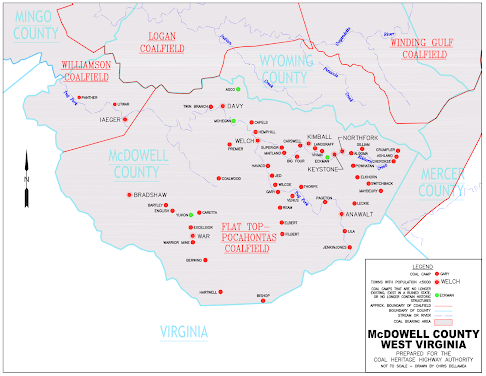McDowell County, VW sits in two major coal fields: Pocahontas Coalfield and Williamson Coalfield. According to the WV Office for Miners Health Safety and Training, in 1883 the Norfolk and Western Railroad lines were completed which led to the growth of the commercial coal industry. Shortly thereafter, mining began in McDowell, WV. The Norfolk & Western Historical Photograph Collection on VT Libraries showcases images of 34 distinct mines in McDowell County from the 1920s to the 1950s (see later blog post for these pictures). Those 34 mines can be seen in the map below as green dots.
Coal Heritage Highway Authority in WV depicts 41 coal camps and 4 abandoned coal camps in McDowell County.
When the coal companies came into West Virginia, they would set up whole community with general stores for the workers to live. However, many workers lived in debt to the coal company and never were able to generate enough wealth to make it out of poverty. AP News emphasizes the terrible conditions for coal miners: "When a miner was killed or disable, his family was kicked out of company housing and left destitute." And miners dying or becoming injured at work was not a rare occurrence. According to the records of the WV Office for Miners Health Safety and Training, on December 29, 1908, an explosion at the Lick Branch Colliery in McDowell County killed 50 miners and just 14 days later on January 12, 1909, another explosion at the same mine killed 67 miners, and in 1925 there was the "highest number of mine fatalities for any year" with the mines claiming 686 lives.
Columbia Political Review explains how the large coal industry were able to stifle job diversification in Appalachian mining towns. Therefore, while McDowell was once the world's leading coal producer, with more and more large mining companies like US Steel Mining Co. leaving the region, there are few job options for residents. Hence, it now is one of the poorest counties in the United States with a median household income of $30,127 in 2021. Not surprisingly, many people are forced to leave their home in order to try to make a living elsewhere. The population in McDowell County has declined from its peak of 98,887 in 1950 to 17,850 in 2021. However, there are still 33 underground mine permits open in McDowell County, according to the WV Office for Miners Health Safety and Training.
Both operating mines and abandoned mine shafts pollute the land and waterways around them. One potential large-scale restoration project is The Reclaim Act which was first introduced to congress in 2016, but has yet to be passed. If passed, it would allocate $1 billion to "help clean up dangerous and polluting abandoned coal mines on public and private lands." The benefits would be twofold: creating new jobs in communities affected by the extractive coal industry and reviving the land and waterways of these communities. The Reclaim Act builds on the Surface Mining Control and Reclamation Act of 1977. The Abandoned Mine Lands program has "eliminated over 45,000 open mine portals, reclaimed over 1,000 miles of stable rock walls, and restored water supplies to countless residents of coal communities."
Many McDowell County residents are worried about the impact of the mines on their sources of drinking water. Lots of residents rely in part on water from roadside springs ("runoff from the rock face of a mountains") as drinking water and their concerns are largely confirmed: E. coli is commonly found in waterways and heavy metals are found in income pipe samples (1, 2, 3). We will explore this in greater detail in October, but for now here are some news articles regarding McDowell County about the residents concerns:





Comments
Post a Comment